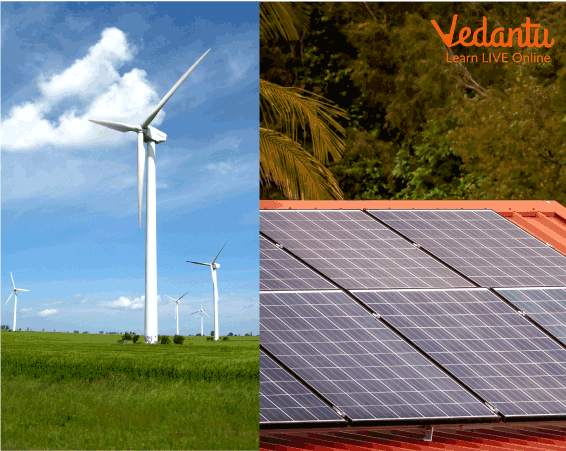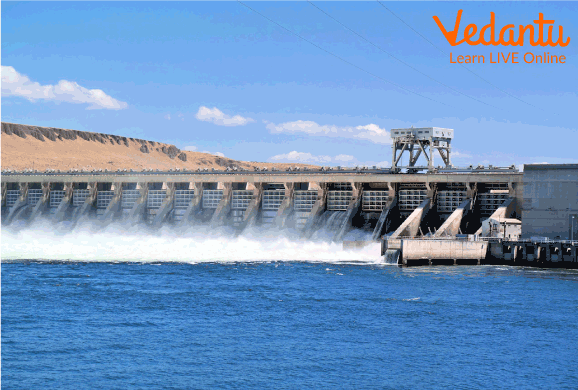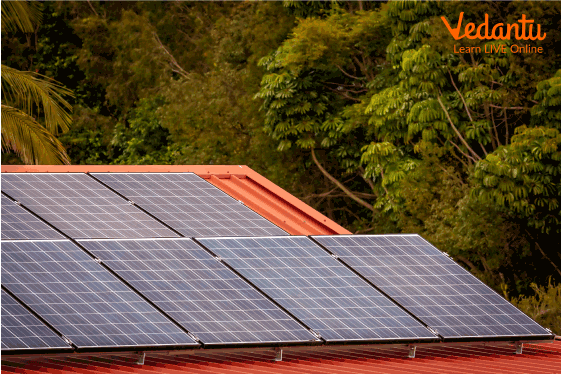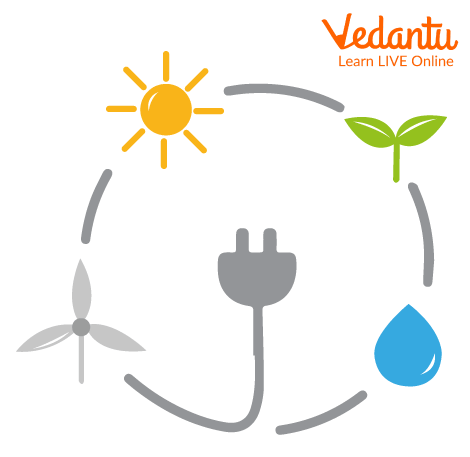




Introduction
We can get energy from various natural sources, which can be modified into forms that humans can easily use for their benefit. These energy resources are available in two forms: renewable and non-renewable energy. Renewable energy is a form of energy that gets renewed after a short period, whereas non-renewable energy does not get renewed and may get exhausted after a particular period.
What is Renewable Energy?
Renewable energy for kids is the form of energy that gets renewed or is present in an abundant form. This form of energy is usually taken from natural resources. They do not produce greenhouse gasses and are a greener and more sustainable option for the Earth. Renewable resources are cost-effective or cheap when compared to non-renewable sources of energy. Some renewable resources examples are the sun, wind, and water.

Wind Turbines and Solar Panels
Types of Renewable Energy
The various sources through which renewable energy can be obtained are the sun, water, wind, heat, and organic material. These sources are modified in a form that can be used by humans easily. Some renewable energy sources examples are given below.
Solar Energy is the most widely used form of energy extracted from the sunlight present during the day. Using technology, the sunlight is changed into electricity which humans can use. Solar panels are used to absorb sunlight. They can absorb sunlight even on cloudy days. These solar panels can be used for about 25-30 years.
Wind Energy can be extracted from the wind using wind turbines. Not all places on Earth are fit for the installation of wind turbines due to the irregular flow of wind. Wind farms are a fantastic way to use sustainable energy, but they must be carefully planned. The primary environmental drawback is that they might disrupt animal migratory patterns.
Hydro Energy is generated by water. Dams are built to harvest energy from water. Hydropower reservoirs frequently provide numerous functions, including drinking water, irrigation water, flood and drought management, and electricity delivery. Hydropower is now the most important renewable energy source in the electrical industry.

Hydropower Generated Through the Dam
Other Resources- The heat generated by the Earth is used to produce electricity by geothermal energy, and energy produced by the plant material along with other biodegradable products is called bioenergy.

Solar Panels
Advantages of Renewable Energy
Clean, secure, and efficient.
There are several techniques for producing renewable energy.
Provides countries with energy independence.
It creates jobs in your neighborhood.
It is not dependent on the main power grid.
Cost-effective.
Environment-friendly.
Electricity is generated at a cheaper cost.
Disadvantages of Renewable Energy
The energy produced cannot be stored.
The setup of the devices is costly.
A large land area is required.
Fun Facts
Solar and wind power is the growing form of renewable energy.
For one year, one wind turbine can power up to 1,500 houses.
In 2021, renewable energy sources produced 38% of global electricity.
Renewable energy accounts for 98.4% of Norway's energy consumption.
If you could capture all of the sunlight that falls on Earth in one hour, you would have enough energy to power the planet for a year.

Renewable Energy Sources
Sample Questions
1. Renewable form of energy does not include
a) Sun
b) Wind
c) Fossil
d) Plant
Ans: Fossil
Explanation: Fossils are made from the dead remains of plants and animals. They get covered by the layers of soil, and the pressure and heat present inside the Earth change them into fossil fuels like petroleum. These forms of energy are very limited and cannot be renewed.
2. Which renewable energy source generates power using rivers or the ocean?
a) Solar energy
b) Wind energy
c) Hydropower
d) Geothermal energy
Ans: Hydropower
Explanation: Solar energy uses the sun as the energy source whereas, wind and geothermal energy use wind and heat generated from Earth as their energy source respectively.
3. Which of the following characterizes renewable energy the best?
a) Energy derived from fossil fuels
b) Energy produced by the burning of something
c) An energy source derived from the sun, wind, and water.
d) All of the above
Ans. An energy source derived from the sun, wind, and water.
Explanation: Renewable energy sources are those energy sources that will not get depleted or finished and are present in nature in large quantities.
Conclusion
In this article we have studied renewable energy. These are the sources of energy that are renewable. They usually exist in the natural world. When asked "what are renewable energy sources," we might respond, "a renewable source is a natural resource that refills the depleted or used amount of resource within a finite time interval on the human time scale, either through natural reproduction or through recurrent processes." Major renewable resources include solar, wind, biomass, and geothermal.
FAQs on Renewable Energy for Kids
1. What are greenhouse gases?
Greenhouse gases (GHGs) are gases in the earth's atmosphere that trap heat and contribute to global warming. The most significant greenhouse gases are carbon dioxide, methane, and water vapour.
2. What is geothermal energy?
Geothermal energy is a renewable energy source derived from the Inner crust. It is generated by the heat produced by the planet. This thermal energy is stored in the earth's core in the form of rocks and fluids.
3. What is bioenergy?
It is a type of renewable energy obtained from organic materials known as biomass, and it may be utilized to generate transportation fuels, heat, power, and goods.
4. What are the advantages of solar energy?
The advantages of solar power are:
100% limitless, renewable, and free energy.
There will be no hazardous or damaging emissions into the atmosphere.
Reduces dependence on fossil fuels.
It eliminates the need to depend on the power grid or natural gas.
5. Name the types of non-renewable forms of energy resources.
Non-renewable resources are classified into four categories: oil, natural gas, coal, and nuclear energy. Oil, natural gas, and coal are different types of fossil fuels.









